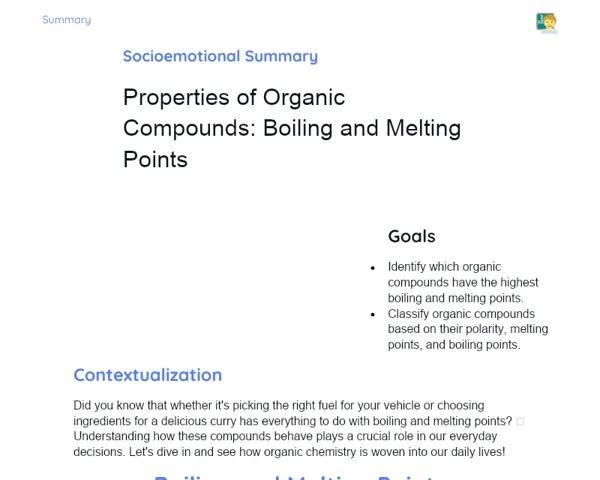Goals
1. Understand the concept of organic series.
2. Identify isologous, homologous, and heterologous series.
3. Apply knowledge to find compounds that belong to an organic series.
Contextualization
Organic Chemistry plays a crucial role in several key industries in India, from pharmaceuticals to petrochemicals, food processing, and cosmetics. Gaining a strong grasp of how organic molecules are classified and behave is vital for fostering innovation and developing indispensable products, including medicines, plastics, and perfumes. For instance, aspirin, a widely used medicine globally, is an organic compound from a homologous series of carboxylic acids. Professionals in research labs—like chemists and pharmacists—rely on their understanding of organic series to formulate new compounds with desired properties, contributing directly to breakthroughs in companies like Bayer and Pfizer.
Subject Relevance
To Remember!
Definition of Organic Series
Organic series comprise groups of organic compounds that exhibit similar structural and chemical properties. These compounds fall into specific series based on patterns in their molecular structures, leading to comparable chemical and physical characteristics.
-
Organic series facilitate systematic classification of compounds.
-
They aid in predicting chemical and physical properties.
-
They are essential for studying and organizing Organic Chemistry.
Isologous Series
Isologous series include molecules that differ by the addition of a methylene group (-CH2). This addition yields a predictable variation in physical properties, like boiling points and solubility.
-
Compounds in an isologous series maintain a constant difference in molecular mass.
-
Physical properties demonstrate predictable changes throughout the series.
-
Examples include methane, ethane, propane, and butane.
Homologous Series
Homologous series consist of compounds with a shared chemical function which differ by one or more methylene groups (-CH2). These compounds show closely related chemical properties with gradual shifts in their physical characteristics.
-
The same chemical function is present throughout the series.
-
Chemical properties are relatively similar.
-
Example: alcohols like methanol, ethanol, and propanol.
Heterologous Series
Heterologous series consist of organic compounds with diverse functional groups, while sharing a common structural framework. Studying these series helps in understanding how different functional groups affect a molecule's properties.
-
Various functional groups are present.
-
Helpful for investigating the influence of functional groups.
-
Example: carboxylic acids and esters derived from the same alkane.
Practical Applications
-
In the pharmaceutical sector, knowledge of organic series is vital for developing new medications like antibiotics and painkillers.
-
In the petrochemical industry, classifying hydrocarbons into series optimizes refining techniques and leads to more efficient fuel production.
-
In polymer manufacturing, recognizing organic series enables the creation of materials with specific characteristics, including heat-resistant plastics.
Key Terms
-
Organic Series: Groups of organic compounds with similar structural and chemical properties.
-
Isologous Series: Compounds differing by a methylene group (-CH2), showcasing predictable variations in physical characteristics.
-
Homologous Series: Compounds sharing the same chemical function, differing by one or more methylene groups (-CH2).
-
Heterologous Series: Compounds with diverse functional groups while maintaining a common structural backbone.
Questions for Reflections
-
How does identifying organic series contribute to product innovation in your everyday life?
-
In what ways do organic series help in understanding the chemistry behind medications?
-
What benefits arise from employing organic series in the petrochemical industry?
Practical Challenge: Building and Classifying Molecular Models
To reinforce our understanding of organic series, we will engage in a practical challenge of building and classifying molecular models.
Instructions
-
Form groups of 4 to 5 students.
-
Utilize molecular modeling kits to create models of the organic compounds listed.
-
Classify the models into isologous, homologous, and heterologous series.
-
Justify your classifications with appropriate reasoning.
-
Present your classifications and justifications to the class.



